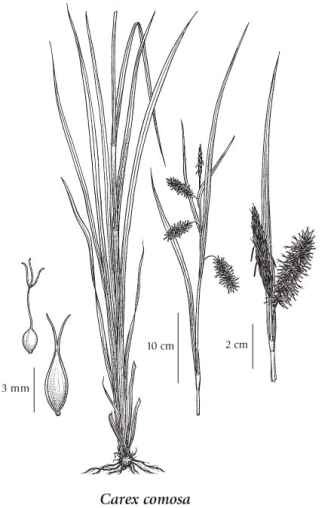bearded sedge (longhair sedge)
Cyperaceae (Sedge family)
Introduction to Vascular Plants
Introduction
Bearded sedge is a perennial rhizomatous species found in North America in many US states and several Canadian provinces (BC, Ontario, Quebec) (USDA 2011). In British Columbia, it is found in the southwestern and south-central regions in shorelines and wet meadows in the lowland, steppe and montane zones.
In writing about the rare plants of the Fraser Valley, Lomer (2011) says: "Local in the Okanagan, rare elsewhere. Old collections from the Fraser Valley from 1912 (UBC: Henry s.n.) up to 1978. Surprisingly, it was discovered at three new sites in the Fraser Valley in 2008, after going un-noticed for a period of several years. It is well adapted to disturbed marshy shores and should be secure in the protected areas it has been found in: Cheam Wetlands Regional Park (UBC: T. Taylor 116), Burnaby Lake (UBC: Lomer 7065), Sumas Mt waterfowl habitat on private property. Also found in 2010 in a railroad ditch west of Agassiz and a wetland east of Agassiz. I suspect that, though native in the Fraser Valley, it has also been introduced as part of waterfowl enhancement plantings." Extracted from Botanical Electronic News #432, January 2011, with permission. A detailed species description is provide by Ball and Reznicek in Flora North America. A detailed discussion on the genus Carex is also provided by Ball and Reznicek.. |
Species Information
General:
Perennial, densely tufted herb from short, stout rhizomes; stems 50-100 cm tall, shorter than the leaves.
Leaves:
Sheaths light brown, the lower ones bladeless; blades several on each stem, flat, 4-11 mm wide, cross-walled, especially on the sheaths.
Flowers:
Spikes 4 to 7, the terminal one lanceolate, 2-6 cm long, with male flowers, the lower 3 to 6 spikes, cylindrical, with female flowers, long-stalked, spreading or nodding; bracts subtending the female spikes tubular-sheathed, leaflike, lower bracts much longer than the inflorescence, the upper ones reduced.
Fruits:
Perigynia lanceolate to narrowly egg-shaped, 5-7.5 mm long, 1.1-1.6 mm wide, pale greenish, convex, smooth above, 15- to 20-nerved, numerous, crowded, spreading or directed downward, short-stalked, the beaks almost as long as the body, bidentate, the teeth 1.2-2.3 mm long, curved outward; female scales egg-shaped, translucent, much shorter than the perigynia, the midribs extending into long rough awns, the awns almost twice as long as the scales; stigmas 3; achenes 3-angled, 1.2-1.8 mm long.
Illustration

If more than one illustration is available for a species (e.g., separate illustrations were provided for two subspecies) then links to the separate images will be provided below. Note that individual subspecies or varietal illustrations are not always available.
Illustration Source: The Illustrated Flora of British Columbia
USDA Species Characteristics
Flower Colour:
Green
Blooming Period:
Mid Summer
Fruit/Seed characteristics:
Colour: Brown
Present over the Summer
Source: The USDA
Ecology
The table below shows the species-specific information calculated from
original data (BEC database) provided by the BC Ministry of Forests and Range.
(Updated August, 2013)
| Site Information |
Value / Class |
||
|
Avg |
Min |
Max |
|
| Elevation
(metres) |
786 | 550 | 1020 |
| Slope
Gradient (%) |
15 | 5 | 35 |
|
Aspect (degrees) |
268 | 220 | 310 |
| Soil
Moisture Regime (SMR) [0 - very xeric; 4 - mesic; 8 - hydric] |
3 | 2 | 4 |
| Modal
Nutrient Regime
Class |
C | ||
| #
of field plots species was recorded in: |
6 | ||
| Modal
BEC Zone Class |
IDF | ||
|
All BEC Zones (# of stations/zone) species was recorded in |
ICH(2), IDF(4) | ||
|
Source:
Klinkenberg 2013
|
|||